SKODA YETI 2010 1.G / 5L Owner's Manual
Manufacturer: SKODA, Model Year: 2010, Model line: YETI, Model: SKODA YETI 2010 1.G / 5LPages: 271, PDF Size: 14.71 MB
Page 181 of 271
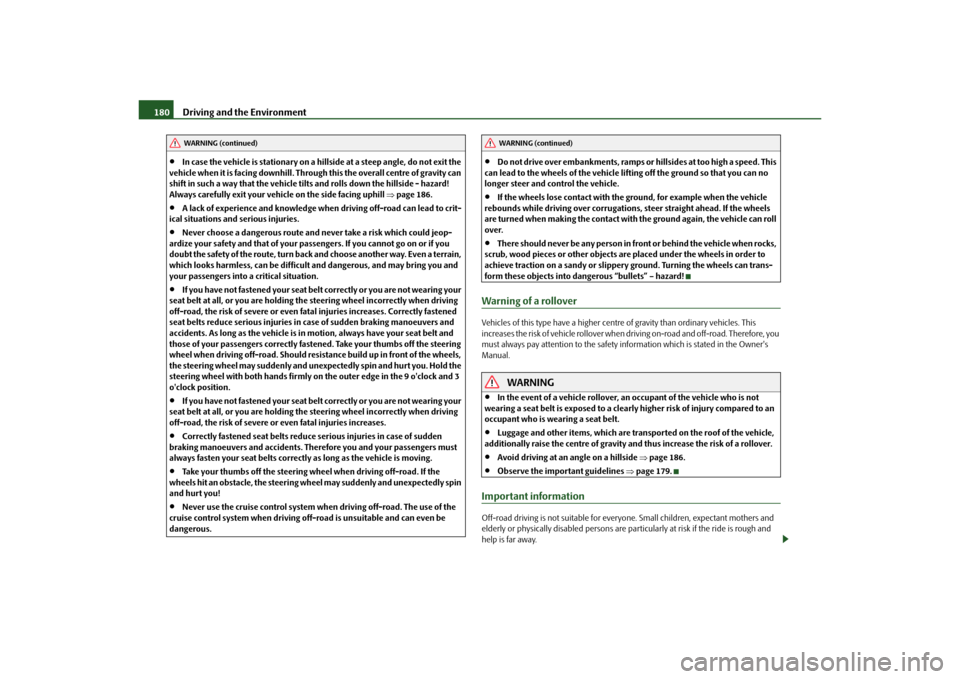
Driving and the Environment
180
In case the vehicle is stationary on a hillside at a steep angl e, do not exit the
vehicle when it is facing downhill. Throug h this the overall centre of gravity can
shift in such a way that the vehicle tilts and rolls down the hillside - hazard!
Always carefully exit your vehicle on the side facing uphill page 186.
A lack of experience and knowledge when driving off-road can lead to crit-
ical situations an d serious injuries.
Never choose a dangerous route and never take a risk which could jeop-
ardize your safety and that of your passengers. If you cannot go on or if you
doubt the safety of the route, turn back and choose another way. Even a terrain,
which looks harmless, can be difficult and dangerous, and may bring you and
your passengers into a critical situation.
If you have not fastened your seat belt correctly or you are not wearing your
seat belt at all, or you are holding the steering wheel incorrectly when driving
off-road, the risk of severe or even fata l injuries increases. Correctly fastened
seat belts reduce serious injuries in case of sudden braking manoeuvers and
accidents. As long as the vehicle is in motion, always have your seat belt and
those of your passen gers correctly fastened. Take yo ur thumbs off the steering
wheel when driving off-road. Should resist ance build up in front of the wheels,
the steering wheel may suddenly and unexpect edly spin and hur t you. Hold the
steering wheel with both hands firmly on the outer edge in the 9 o'clock and 3
o'clock position.
If you have not fastened your seat belt correctly or you are not wearing your
seat belt at all, or you are holding the steering wheel incorrectly when driving
off-road, the risk of severe or even fatal injuries increases.
Correctly fastened seat belts reduce serious injuries in case of sudden
braking manoeuvers and accidents. Th erefore you and your passengers must
always fasten your seat belts correctl y as long as the vehicle is moving.
Take your thumbs off the steering wh eel when driving off-road. If the
wheels hit an obstac le, the steering wheel may suddenly and unexpectedly spin
and hurt you!
Never use the cruise control system wh en driving off-road. The use of the
cruise control system when driving of f-road is unsuitable and can even be
dangerous.
Do not drive over embankments, ramps or hillsides at too high a speed. This
can lead to the wheels of the vehicle lifting off the ground so that you can no
longer steer and control the vehicle.
If the wheels lose contact with the ground, for example when the vehicle
rebounds while driving over corrugations, steer straight ahead. If the wheels
are turned when making the contact with the ground again, the vehicle can roll
over.
There should never be any person in front or behind the vehicle when rocks,
scrub, wood pieces or other objects ar e placed under the wheels in order to
achieve traction on a sandy or slippery ground. Turning the wheels can trans-
form these objects into dangerous “bullets” – hazard!
Warning of a rolloverVehicles of this type have a higher centre of gravity than ordinary vehicles. This
increases the risk of vehicle rollover when driving on-road and off-road. Therefore, you
must always pay attention to the safety information which is stated in the Owner's
Manual.
WARNING
In the event of a vehicle rollover, an occupant of the vehicle who is not
wearing a seat belt is exposed to a clearly higher risk of injury compared to an
occupant who is wearing a seat belt.
Luggage and other items, which are transported on the roof of the vehicle,
additionally raise the centre of gravity and thus increase the risk of a rollover.
Avoid driving at an angle on a hillside page 186.
Observe the important guidelines page 179.
Important informationOff-road driving is not suitable for everyone. Small children, expectant mothers and
elderly or physically di sabled persons are particularly at risk if the ride is rough and
help is far away.
WARNING (continued)
WARNING (continued)
s2ug.6.book Page 180 Friday, April 9, 2010 2:24 PM
Page 182 of 271

Driving and the Environment181
Using the system
Safety
Driving Tips
General Maintenance
Breakdown assistance
Technical Data
The first priority
should always be safety.
Never overestimate your own capabilities and never underestimate the difficulties of
driving off-road.
We cannot discuss all the possible driving situations in this manual, because there are
so many types of terrains which may hide different risks and dangers. The examples
listed in this manual are general rules for safe off-road driving. It is however not
possible to predict if these rules are valid for all the situations which may occur. Before
driving through unknown terrain, it is ther efore important that you know what lies
ahead of you. This way you can estima te any possible danger in advance.
For the sake of the environment
When driving off-road, show respect and appreciation for the environment and its
preservation for future generations.Before driving off-road for the first timeBefore driving off-road, we recommend that you take part in an Off-road driver
training course. This is especial l y i m p o r t a n t i f y o u h a v e l i t t l e o r n o e x p e r i e n c e o f d r i v i n g
off-road. In a driver training course, you learn how to use th e vehicle in many different
off-road situations and how to handle the vehicle safely when driving through rough
terrain.
Driving off-road requires entirely different skills from the driver and a very different
behaviour than driving on the road. Your pers onal safety and that of your passengers
depend on you, your capabili ties and your cautiousness.
Do not drive off-road where it is not suitable for your vehicle or where the demands
on you are too high. Although your vehicle can handle off-road driving, it is not
designed for travels with expedition characteristics.
Before each journey off-road, make sure that the vehicle is appropriately equipped for
the planned journey page 182. The standard equipmen t of your vehicle may not be
sufficient for your journey. With the standard tyres you can drive with your off-road
vehicle through easy terrain, such as flat forest roads, meadows and fields. Please note
however, that driving the vehicle on a diffic ult, muddy and sandy ground is restricted
and that the traction of the standard tyres is reduced when driving off-road. If you have
planned prolonged or difficul t off-road trips, we recommend that you equip your
vehicle with suitable off-road tyres.
WARNING
Observe the important guidelines page 179.Rules of conduct for responsible off-road drivingObserve the valid national legal requirements when driving off-road.Explanation of technical termsFig. 155 Embankment angle / slope angle
Fig. 156 Ground clearance / ramp angleThe technical data page 245, “Angle (in degree)” refer to ideal conditions. These
values may differ depending on the load and composition of the soil and the environ-
ment. The driver is responsible to decide whether a vehicle can overcome a certain
situation.
s2ug.6.book Page 181 Friday, April 9, 2010 2:24 PM
Page 183 of 271
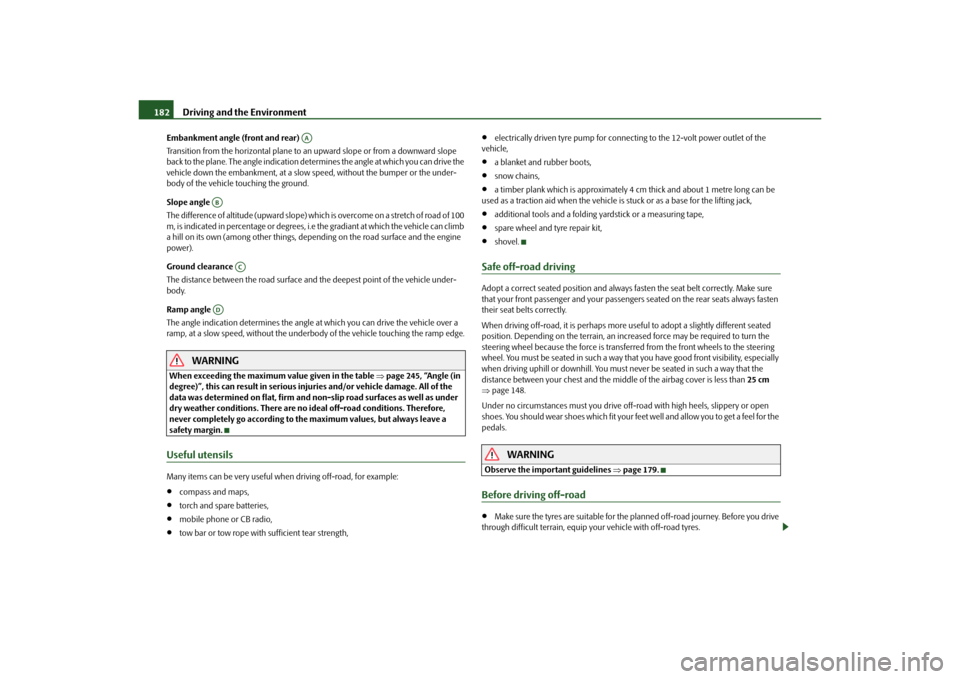
Driving and the Environment
182
Embankment angle (front and rear)
Transition from the horizontal plane to an upward slope or from a downward slope
back to the plane. The angle indication determines the angle at which you can drive the
vehicle down the embankment, at a slow speed, without the bumper or the under-
body of the vehicle touching the ground.
Slope angle
The difference of altitude (upward slope) which is overcome on a stretch of road of 100
m, is indicated in percentage or degrees, i. e the gradiant at which the vehicle can climb
a hill on its own (among other things, depe nding on the road surface and the engine
power).
Ground clearance
The distance between the road surface and the deepest point of the vehicle under-
body.
Ramp angle
The angle indication determines the angle at which you can drive the vehicle over a
ramp, at a slow speed, without the underbody of the vehicle touching the ramp edge.
WARNING
When exceeding the maximum value given in the table page 245, “Angle (in
degree)”, this can result in serious inju ries and/or vehicle damage. All of the
data was determined on flat, firm and no n-slip road surfaces as well as under
dry weather conditions. There are no id eal off-road conditions. Therefore,
never completely go according to the maximum values, but always leave a
safety margin.Useful utensilsMany items can be very useful wh en driving off-road, for example:
compass and maps,
torch and spare batteries,
mobile phone or CB radio,
tow bar or tow rope with sufficient tear strength,
electrically driven tyre pump for connect ing to the 12-volt power outlet of the
vehicle,
a blanket and rubber boots,
snow chains,
a timber plank which is approximately 4 cm thick and about 1 metre long can be
used as a traction aid when the vehicle is stuck or as a base for the lifting jack,
additional tools and a folding yardstick or a measuring tape,
spare wheel and tyre repair kit,
shovel.
Safe off-road drivingAdopt a correct seated position and always fa sten the seat belt correctly. Make sure
that your front passenger and your passengers seated on the rear seats always fasten
their seat belts correctly.
When driving off-road, it is perhaps more useful to adopt a slightly different seated
position. Depending on the terrain, an incr eased force may be required to turn the
steering wheel because the force is transferred from the front wheels to the steering
wheel. You must be seated in such a way that you have good front visibility, especially
when driving uphill or downhill. You must never be seated in such a way that the
distance between your chest and the midd le of the airbag cover is less than 25 cm
page 148.
Under no circumstances must you drive off-ro ad with high heels, slippery or open
shoes. You should wear shoes which fit your feet well and allow you to get a feel for the
pedals.
WARNING
Observe the important guidelines page 179.Before driving off-road
Make sure the tyres are suitable for the pl anned off-road journey. Be fore you dri ve
through difficult terrain, equip yo ur vehicle with off-road tyres.
AA
AB
AC
AD
s2ug.6.book Page 182 Friday, April 9, 2010 2:24 PM
Page 184 of 271
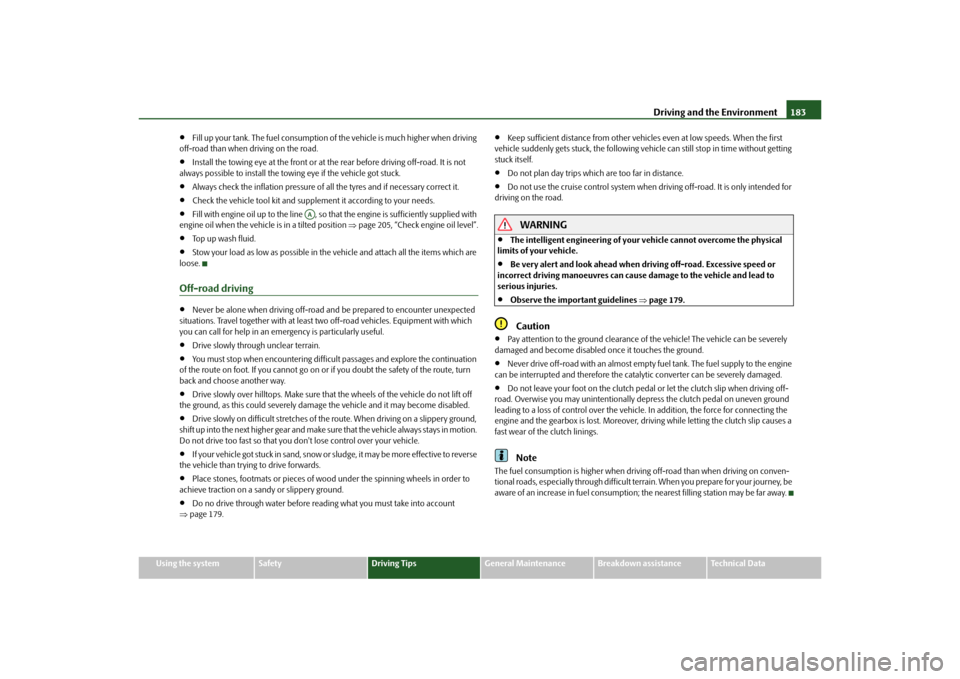
Driving and the Environment183
Using the system
Safety
Driving Tips
General Maintenance
Breakdown assistance
Technical Data
Fill up your tank. The fuel consumption of the vehicle is much higher when driving
off-road than when driving on the road.
Install the towing eye at the front or at the rear before driving off-road. It is not
always possible to install the towing eye if the vehicle got stuck.
Always check the inflation pressure of a ll the tyres and if necessary correct it.
Check the vehicle tool kit and supplement it according to your needs.
Fill with engine oil up to the line , so that the engine is sufficiently supplied with
engine oil when the vehicle is in a tilted position page 205, “Check engine oil level”.
Top up wash fluid.
Stow your load as low as possible in th e vehicle and attach all the items which are
loose.
Off-road driving
Never be alone when driving off-road and be prepared to encounter unexpected
situations. Travel together with at least two off-road vehicles. Equipment with which
you can call for help in an emer gency is particularly useful.
Drive slowly through unclear terrain.
You must stop when encountering difficul t passages and explore the continuation
of the route on foot. If you cannot go on or if you doubt the safety of the route, turn
back and choose another way.
Drive slowly over hilltops. Ma ke sure that the wheels of the vehicle do not lift off
the ground, as this could severely damage the vehicle and it may become disabled.
Drive slowly on difficult stretches of the route. When driving on a slippery ground,
s h i f t u p i n to t h e n e xt h i g h e r g e a r a n d m a ke s u re t h a t t he v e h i c l e a l w a y s s t a y s i n m o t i o n.
Do not drive too fast so that you do n't lose control over your vehicle.
If your vehicle got stuck in sand, snow or sludge, it may be more effective to reverse
the vehicle than trying to drive forwards.
Place stones, footmats or pieces of wood under the spinning wheels in order to
achieve traction on a sandy or slippery ground.
Do no drive throug h water before reading what you must take into account
page 179.
Keep sufficient distance from other vehicles even at low speeds. When the first
vehicle suddenly gets stuck, the following vehi cle can still stop in time without getting
stuck itself.
Do not plan day trips which are too far in distance.
Do not use the cruise control system when driving off-road. It is only intended for
driving on the road.
WARNING
The intelligent engineering of your ve hicle cannot overcome the physical
limits of your vehicle.
Be very alert and look ahead when driving off-road. Excessive speed or
incorrect driving manoeuvres can caus e damage to the vehicle and lead to
serious injuries.
Observe the important guidelines page 179.Caution
Pay attention to the ground clearance of the vehicle! The vehicle can be severely
damaged and become disabled once it touches the ground.
Never drive off-road with an almost empty fuel tank. The fuel supply to the engine
can be interrupted and therefore the cata lytic converter can be severely damaged.
Do not leave your foot on the clutch pedal or let the clutch slip when driving off-
road. Overwise you may unintentionally de press the clutch pedal on uneven ground
leading to a loss of control over the vehicle. In addition, the force for connecting the
engine and the gearbox is lost. Moreover, driving while letting the clutch slip causes a
fast wear of the clutch linings.Note
The fuel consumption is high er when driving off-road than when driving on conven-
tional roads, especially through difficult terr ain. When you prepare for your journey, be
aware of an increase in fuel consumption; the nearest filling station may be far away.
AA
s2ug.6.book Page 183 Friday, April 9, 2010 2:24 PM
Page 185 of 271
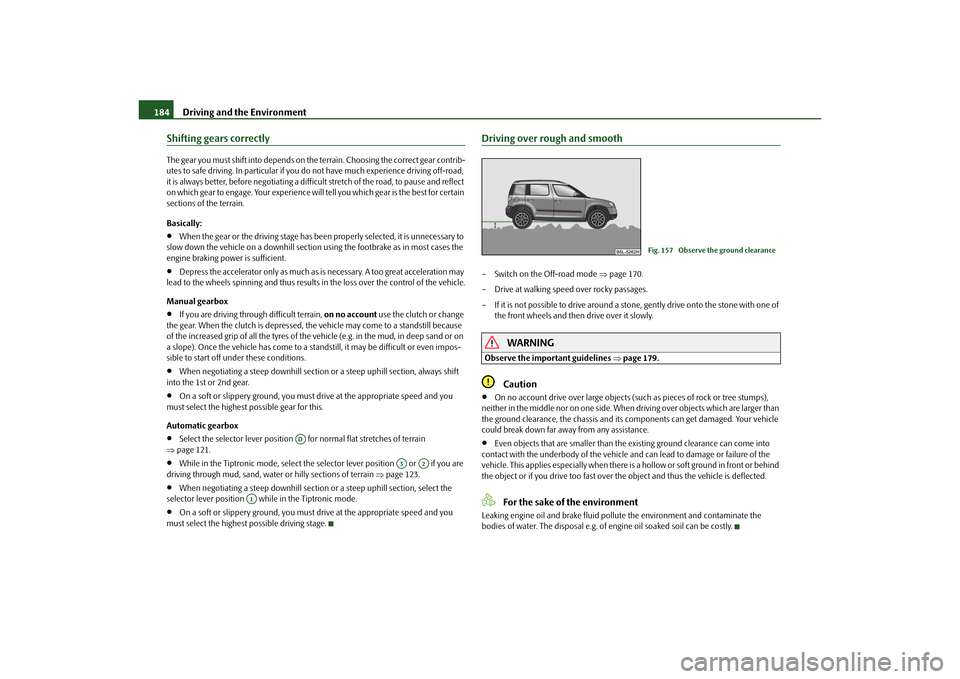
Driving and the Environment
184
Shifting gears correctlyThe gear you must shift into depends on th e terrain. Choosing the correct gear contrib-
utes to safe driving. In partic ular if you do not have much experience driving off-road,
it is always better, before negotiating a difficult stretch of the road, to pause and reflect
on which gear to engage. Your experience will tell you which gear is the best for certain
sections of the terrain.
Basically:
When the gear or the driving stage has been properly selected, it is unnecessary to
slow down the vehicle on a downhill sectio n using the footbrake as in most cases the
engine braking power is sufficient.
Depress the accelerator only as much as is necessary. A too great acceleration may
lead to the wheels spinning and thus results in the loss over the control of the vehicle.
Manual gearbox
If you are driving thro ugh difficult terrain, on no account use the clutch or change
the gear. When the clutch is depressed, th e vehicle may come to a standstill because
of the increased grip of all the tyres of the vehicle (e.g. in the mud, in deep sand or on
a slope). Once the vehicle has come to a stan dstill, it may be difficult or even impos-
sible to start off under these conditions.
When negotiating a steep downhill section or a steep uphill section, always shift
into the 1st or 2nd gear.
On a soft or slippery ground, you must drive at the appropriate speed and you
must select the highest possible gear for this.
Automatic gearbox
Select the selector lever position for normal flat stretches of terrain
page 121.
While in the Tiptronic mode, select the se lector lever position or if you are
driving through mud, sand, water or hilly sections of terrain page 123.
When negotiating a steep downhill section or a steep uphill section, select the
selector lever position while in the Tiptronic mode.
On a soft or slippery ground, you must drive at the appropriate speed and you
must select the highest possible driving stage.
Driving over rough and smooth– Switch on the Off-road mode page 170.
– Drive at walking speed over rocky passages.
– If it is not possible to drive around a stone, gently drive onto the stone with one of the front wheels and then drive over it slowly.
WARNING
Observe the important guidelines page 179.
Caution
On no account drive over large objects (suc h as pieces of rock or tree stumps),
neither in the middle nor on one side. When driving over objects which are larger than
the ground clearance, the chassis and its components can get damaged. Your vehicle
could break down far away from any assistance.
Even objects that are smaller than the existing ground clearance can come into
contact with the underbody of the vehicle an d can lead to damage or failure of the
vehicle. This applies especially when there is a hollow or soft ground in front or behind
the object or if you drive too fast over the object and thus the vehicle is deflected.For the sake of the environment
Leaking engine oil and brake fluid poll ute the environment and contaminate the
bodies of water. The disposal e.g. of engine oil soaked soil can be costly.
AD
A3
A2
A1
Fig. 157 Observe the ground clearance
s2ug.6.book Page 184 Friday, April 9, 2010 2:24 PM
Page 186 of 271
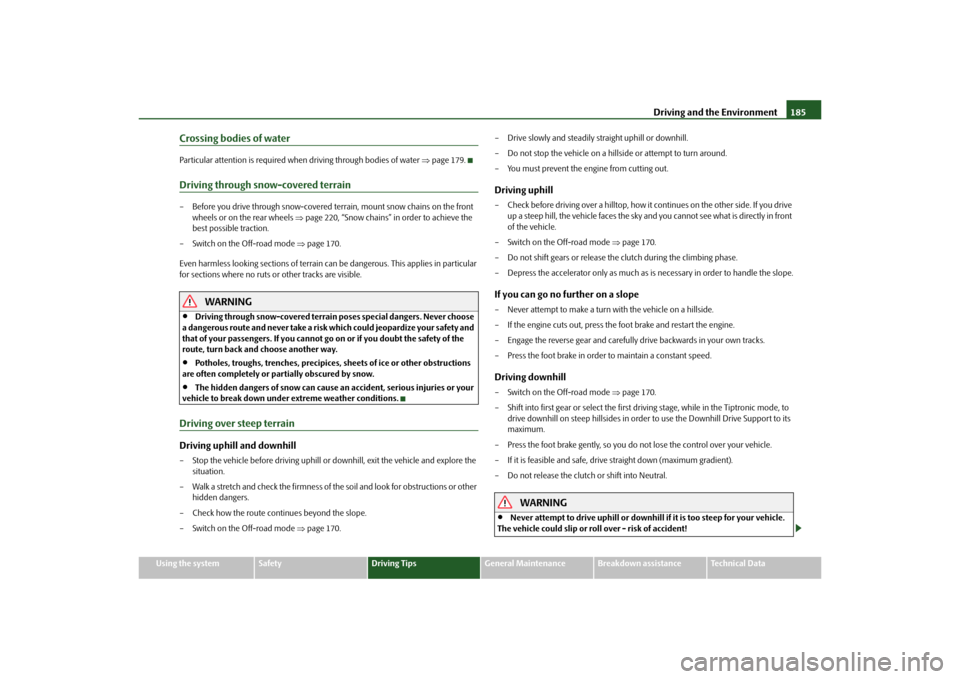
Driving and the Environment185
Using the system
Safety
Driving Tips
General Maintenance
Breakdown assistance
Technical Data
Crossing bodies of waterParticular attention is required when driving through bodies of water page 179.Driving through snow-covered terrain– Before you drive through snow-covered te rrain, mount snow chains on the front
wheels or on the rear wheels page 220, “Snow chains” in order to achieve the
best possible traction.
–Switch on the Off-road mode page 170.
Even harmless looking sections of terrain can be dangerous. This applies in particular
for sections where no ruts or other tracks are visible.
WARNING
Driving through snow-covered terrain poses special dangers. Never choose
a dangerous route and never take a risk which could jeopardize your safety and
that of your passengers. If you cannot go on or if you doubt the safety of the
route, turn back and choose another way.
Potholes, troughs, trenches, precipices , sheets of ice or other obstructions
are often completely or partially obscured by snow.
The hidden dangers of snow can cause an accident, serious injuries or your
vehicle to break down under extreme weather conditions.
Driving over steep terrainDriving uphill and downhill– Stop the vehicle before driv ing uphill or downhill, exit the vehicle and explore the
situation.
– Walk a stretch and check the firmness of the soil and look for obstructions or other hidden dangers.
– Check how the route continues beyond the slope.
–Switch on the Off-road mode page 170. – Drive slowly and steadily straight uphill or downhill.
– Do not stop the vehicle on a hillside or attempt to turn around.
– You must prevent the engine from cutting out.
Driving uphill– Check before driving over a hilltop, how it
continues on the other side. If you drive
up a steep hill, the vehicle faces the sky and you cannot see what is directly in front
of the vehicle.
– Switch on the Off-road mode page 170.
– Do not shift gears or release the clutch during the climbing phase.
– Depress the accelerator only as much as is necessary in order to handle the slope.If you can go no further on a slope– Never attempt to make a turn with the vehicle on a hillside.
– If the engine cuts out, press the foot brake and restart the engine.
– Engage the reverse gear and carefully drive backwards in your own tracks.
– Press the foot brake in order to maintain a constant speed.Driving downhill– Switch on the Off-road mode page 170.
– Shift into first gear or select the first driving stage, while in the Tiptronic mode, to drive downhill on steep hillsides in order to use the Downhill Drive Support to its
maximum.
– Press the foot brake gently, so you do not lose the control over your vehicle.
– If it is feasible and safe, drive straight down (maximum gradient).
– Do not release the clutch or shift into Neutral.
WARNING
Never attempt to drive uphill or downhill if it is too steep for your vehicle.
The vehicle could slip or roll over - risk of accident!
s2ug.6.book Page 185 Friday, April 9, 2010 2:24 PM
Page 187 of 271
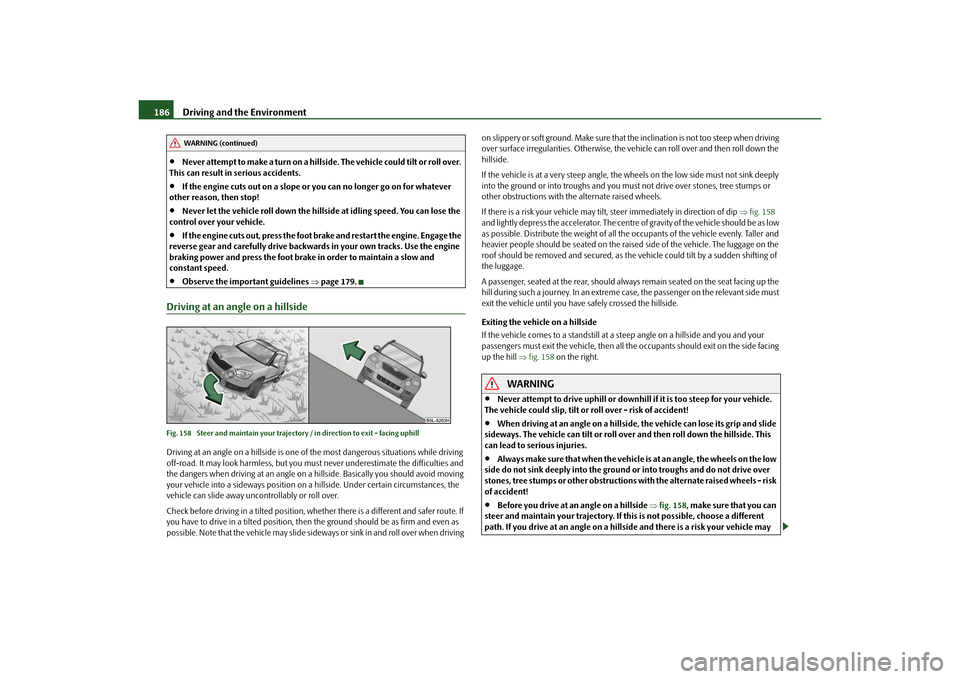
Driving and the Environment
186
Never attempt to make a turn on a hillside. The vehicle could tilt or roll over.
This can result in serious accidents.
If the engine cuts out on a slope or you can no longer go on for whatever
other reason, then stop!
Never let the vehicle roll down the hill side at idling speed. You can lose the
control over your vehicle.
If the engine cuts out, press the foot brake and restart the engine. Engage the
reverse gear and carefully drive backward s in your own tracks. Use the engine
braking power and press the foot brake in order to maintain a slow and
constant speed.
Observe the important guidelines page 179.
Driving at an angle on a hillsideFig. 158 Steer and maintain your trajectory / in direction to exit - facing uphillDriving at an angle on a hillside is one of the most dangerous situations while driving
off-road. It may look harmless, but you must never underestimate the difficulties and
the dangers when driving at an angle on a hillside. Basically you should avoid moving
your vehicle into a sideways position on a hillside. Under certain circumstances, the
vehicle can slide away uncon trollably or roll over.
Check before driving in a tilted position, whether there is a different and safer route. If
you have to drive in a tilted position, then the ground should be as firm and even as
possible. Note that the vehicle may slide sideways or sink in and roll over when driving on slippery or soft ground. Make sure that
the inclination is not too steep when driving
over surface irregularities. Otherwise, the vehicle can roll over and then roll down the
hillside.
If the vehicle is at a very steep angle, the wheels on the low side must not sink deeply
into the ground or into troughs and you mu st not drive over stones, tree stumps or
other obstructions with the alternate raised wheels.
If there is a risk your ve hicle may tilt, steer immedi ately in direction of dip fig. 158
and lightly depress the accelerator. The centre of gravity of the vehicle should be as low
as possible. Distribute the weight of all the occupants of the vehicle evenly. Taller and
heavier people should be seated on the rais ed side of the vehicle. The luggage on the
roof should be removed and secured, as the vehicle could tilt by a sudden shifting of
the luggage.
A passenger, seated at the rear, should always remain seated on the seat facing up the
hill during such a journey. In an extreme case , the passenger on the relevant side must
exit the vehicle until you have safely crossed the hillside.
Exiting the vehicle on a hillside
If the vehicle comes to a standstill at a st eep angle on a hillside and you and your
passengers must exit the vehicle, then all th e occupants should exit on the side facing
up the hill fig. 158 on the right.
WARNING
Never attempt to drive uphill or downhill if it is too steep for your vehicle.
The vehicle could slip, tilt or roll over - risk of accident!
When driving at an angle on a hillside, the vehicle can lose its grip and slide
sideways. The vehicle can tilt or roll over and then roll down the hillside. This
can lead to serious injuries.
Always make sure that when the vehicle is at an angle, the wheels on the low
side do not sink deeply into the ground or into troughs and do not drive over
stones, tree stumps or other obstructions with the alternate raised wheels - risk
of accident!
Before you drive at an angle on a hillside fig. 158 , make sure that you can
steer and maintain your trajectory. If this is not possible, choose a different
path. If you drive at an an gle on a hillside and there is a risk your vehicle may
WARNING (continued)
s2ug.6.book Page 186 Friday, April 9, 2010 2:24 PM
Page 188 of 271
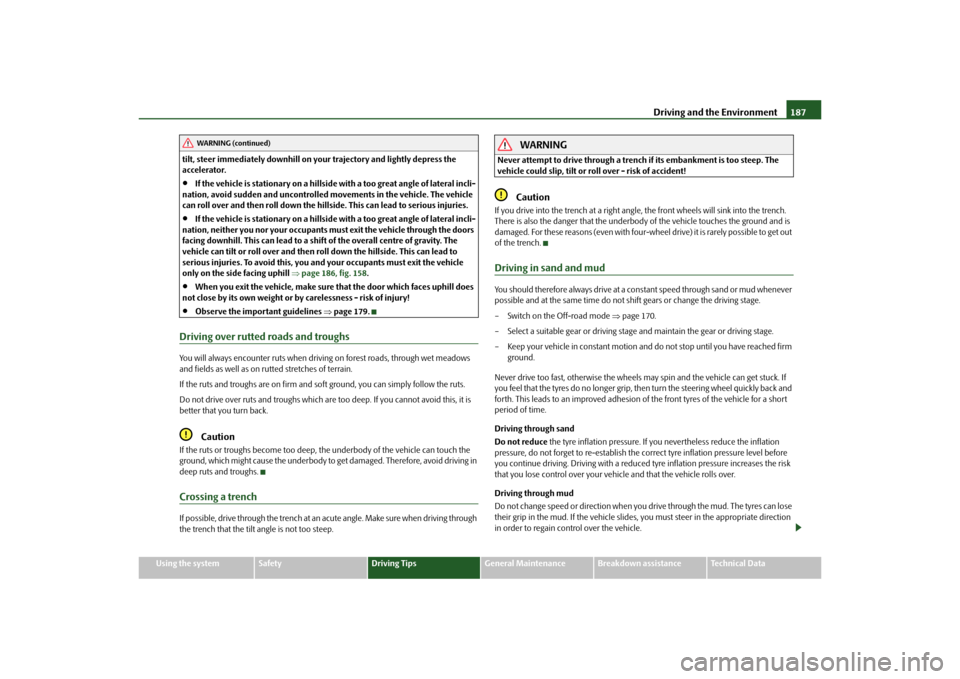
Driving and the Environment187
Using the system
Safety
Driving Tips
General Maintenance
Breakdown assistance
Technical Data
tilt, steer immediat
ely downhill on your trajec tory and lightly depress the
accelerator.
If the vehicle is stationary on a hillside with a too great angle of lateral incli-
nation, avoid sudden and uncontrolled movements in the vehicle. The vehicle
can roll over and then roll down the hillside. This can lead to serious injuries.
If the vehicle is stationary on a hillside with a too great angle of lateral incli-
nation, neither you nor your occupants must exit the vehicle through the doors
facing downhill. This can lead to a shift of the overall centre of gravity. The
vehicle can tilt or roll over and then roll down the hillside. This can lead to
serious injuries. To avoid this, you and your occupants must exit the vehicle
only on the side facing uphill page 186, fig. 158.
When you exit the vehicle, make sure that the door which faces uphill does
not close by its own weight or by carelessness - risk of injury!
Observe the important guidelines page 179.
Driving over rutted roads and troughsYou will always encounter ruts when driv ing on forest roads, through wet meadows
and fields as well as on rutted stretches of terrain.
If the ruts and troughs are on firm and soft ground, you can simply follow the ruts.
Do not drive over ruts and troughs which ar e too deep. If you cannot avoid this, it is
better that you turn back.
Caution
If the ruts or troughs become too deep, the underbody of the vehicle can touch the
ground, which might cause the underbody to get damaged. Therefore, avoid driving in
deep ruts and troughs.Crossing a trenchIf possible, drive through the trench at an acute angle. Make sure when driving through
the trench that the tilt angle is not too steep.
WARNING
Never attempt to drive through a trench if its embankment is too steep. The
vehicle could slip, tilt or roll over - risk of accident!
Caution
If you drive into the trench at a right angle, the front wheels will sink into the trench.
There is also the danger that the underbod y of the vehicle touches the ground and is
damaged. For these reasons (even with four-wheel drive) it is rarely possible to get out
of the trench.Driving in sand and mudYou should therefore always drive at a cons tant speed through sand or mud whenever
possible and at the same time do not shift gears or change the driving stage.
– Switch on the Off-road mode page 170.
– Select a suitable gear or driving stage and maintain the gear or driving stage.
– Keep your vehicle in constant motion and do not stop until you have reached firm
ground.
Never drive too fast, otherwise the wheels may spin and the vehicle can get stuck. If
you feel that the tyres do no longer grip, then turn the steering wheel quickly back and
forth. This leads to an improved adhesion of the front tyres of the vehicle for a short
period of time.
Driving through sand
Do not reduce the tyre inflation pressure. If yo u nevertheless reduce the inflation
pressure, do not forget to re-establish the correct tyre inflation pressure level before
you continue driving. Driving with a reduced tyre inflation pressure increases the risk
that you lose control over your vehicle and that the vehicle rolls over.
Driving through mud
Do not change speed or direction when you drive through the mud. The tyres can lose
their grip in the mud. If the vehicle slides, you must steer in the appropriate direction
in order to regain control over the vehicle.
WARNING (continued)
s2ug.6.book Page 187 Friday, April 9, 2010 2:24 PM
Page 189 of 271
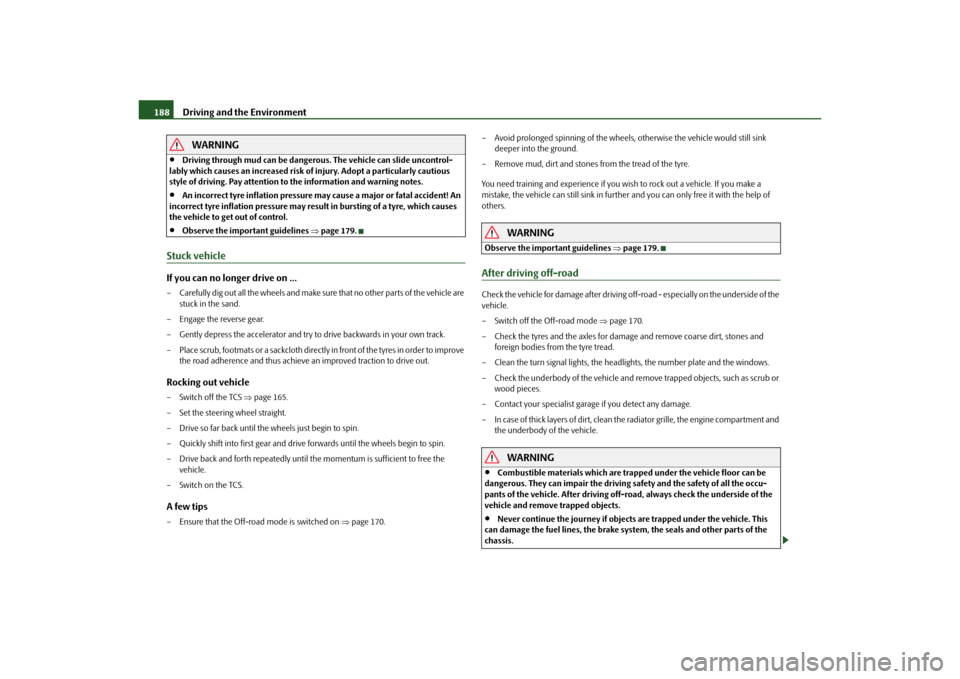
Driving and the Environment
188WARNING
Driving through mud can be dangerous. The vehicle can slide uncontrol-
lably which causes an increased risk of injury. Adopt a particularly cautious
style of driving. Pay attention to the information and warning notes.
An incorrect tyre inflation pressure may cause a major or fatal accident! An
incorrect tyre inflation pressure may result in bursting of a tyre, which causes
the vehicle to get out of control.
Observe the important guidelines page 179.
Stuck vehicleIf you can no longer drive on ...– Carefully dig out all the wheels and make sure that no other parts of the vehicle are
stuck in the sand.
– Engage the reverse gear.
– Gently depress the accelerator and try to drive backwards in your own track.
– Place scrub, footmats or a sackcloth directly in front of the tyres in order to improve
the road adherence and thus achieve an improved traction to drive out.Rocking out vehicle–Switch off the TCS page 165.
– Set the steering wheel straight.
– Drive so far back until the wheels just begin to spin.
– Quickly shift into first gear and drive forwards until the wheels begin to spin.
– Drive back and forth repeatedly until the momentum is sufficient to free the vehicle.
–Switch on the TCS.A few tips– Ensure that the Off-road mode is switched on page 170. – Avoid prolonged spinning of the wheels, otherwise the vehicle would still sink
deeper into the ground.
– Remove mud, dirt and stones from the tread of the tyre.
You need training and experience if you wish to rock out a vehicle. If you make a
mistake, the vehicle can still sink in further and you can only free it with the help of
others.
WARNING
Observe the important guidelines page 179.After driving off-roadCheck the vehicle for damage after driving off-road - especially on the underside of the
vehicle.
– Switch off the Off-road mode page 170.
– Check the tyres and the axles for damage and remove coarse dirt, stones and foreign bodies from the tyre tread.
– Clean the turn signal lights, the headlights, the number plate and the windows.
– Check the underbody of the vehicle and remove trapped objects, such as scrub or wood pieces.
– Contact your specialist gara ge if you detect any damage.
– In case of thick layers of dirt, clean the radiator grille, the engine compartment and the underbody of the vehicle.
WARNING
Combustible materials which are tra pped under the vehicle floor can be
dangerous. They can impair the driving safety and the safety of all the occu-
pants of the vehicle. After driving off-road, always check the underside of the
vehicle and remove trapped objects.
Never continue the journey if objects are trapped under the vehicle. This
can damage the fuel lines, the brake system, the seals and other parts of the
chassis.
s2ug.6.book Page 188 Friday, April 9, 2010 2:24 PM
Page 190 of 271

Driving and the Environment189
Using the system
Safety
Driving Tips
General Maintenance
Breakdown assistance
Technical Data
Combustible objects such as dry leaves or twigs could ignite on hot vehicle
parts. A vehicle fire can also lead to serious injuries.
Observe the important guidelines page 179.WARNING (continued)
s2ug.6.book Page 189 Friday, April 9, 2010 2:24 PM